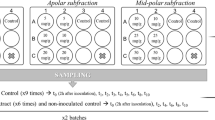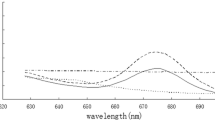Abstract
The methylated soybean protein and methylated chickpea protein (MSP and MCP) with isoelectric points around pI 8 were prepared by esterifying 83 % of their free carboxyl groups and tested for their interactions with Listeria monocytogenes and Salmonella Enteritidis. The two substances exhibited a concentration-dependent inhibitory action against the two studied bacteria with a minimum inhibitory concentration of about 100 μg/mL. The IC50 % of the two proteins against L. monocytogenes (17 μg/mL) was comparable to penicillin but comparatively much lower (15 μg/mL) than that of penicillin (85 μg/mL) against S. Enteritidis. The two proteins could inhibit the growth of L. monocytogenes and S. Enteritidis by about 97 and 91 %, respectively, after 6–12 h of incubation at 37 °C. The constituting subunits of MSP (methylated 11S and methylated 7S) were both responsible for its antimicrobial action. Transmission electron microscopy of the protein-treated bacteria showed various signs of cellular deformation. The cationic proteins can electrostatically and hydrophobically interact with cell wall and cell membrane, producing large pores, pore channels and cell wall and cell membrane disintegration, engendering higher cell permeability leading finally to cell emptiness, lysis and death.







Similar content being viewed by others
References
Mead PS, Slutsker L, Dietz V, McCaig LF, Bresee JS, Shapiro C, Griffin PM, Tauxe RV (1999) Food-related illness and death in the United States. Emerg Infect Dis 5:607–625
Nørrung B, Buncic S (2008) Microbial safety of meat in the European Union. Meat Sci 78:14–24
Gandhi M, Chikindas ML (2007) Listeria: a foodborne pathogen that knows how to survive. Int J Food Microb 113:1–15
Jofré A, Aymerich T, Garriga M (2008) Assessment of the effectiveness of antimicrobial packaging combined with high pressure to control Salmonella sp. in cooked ham. Food Cont 19:634–638
EC European Parliament and Council of the European Community (2005) Commission regulation (EC) No. 2073/2005 of 15 November 2005 on microbiological criteria for foodstuffs. Official Journal of the European Union, L338, 1–26. Brussels, Belgium
Nanda A, Saravanan M (2009) Biosynthesis of silver nanoparticles from Staphylococcus aureus and its antimicrobial activity against MRSA and MRSE. Nanomedicine 5:452–456
Friedrich CL, Moyles D, Beveridge TJ, Hancock REW (2000) Antimicrobial action of structurally diverse cationic peptides on Gram-positive bacteria. Antimicrob Agents Chemother 44:2086–2092
Giuliani A, Pirri G, Rinaldi AC (2010) Antimicrobial peptides: the LPS connection. Methods Mol Biol 618:137–154
Sitohy M, Osman A (2010) Antimicrobial activity of native and esterified legume proteins against Gram-negative and Gram-positive bacteria. Food Chem 120:66–73
Mahgoub S, Sitohy M, Osman A (2011) Inhibition of growth of pathogenic bacteria in raw milk by legume protein esters. J Food Prot 74:1475–1481
Johnson EA, Brekke J (1983) Functional properties of acylated pea protein isolates. J Food Sci 48:722–725
AACC (2000) Crude protein-Micro Kjeldahl method. In: Approved methods of the AACC, 10th edn, vol II. AACC method, pp 46–13
Sitohy MZ, Chobert J-M, Haertle T (2000) Factors influencing protein esterification reaction using β-Lacto globulin as a model protein. J Food Biochem 24:381–398
Bertrand-Harb C, Chobert J-M, Dufour E, Haertle T (1991) Esterification of food proteins: characterization of the derivatives by a colorimetric method and by electrophoresis. Sci Alimen 11:641–652
Nagano T, Hirotsuka M, Mori H, Kohyama K, Nishinari K (1992) Dynamic viscoelastic study on the gelation of 7S globulin from soybeans. J Agric Food Chem 40:941–944
Laemmli UK (1970) Cleavage of structural proteins during the assembly of head of bacteriophage T4. Nature 227:680–685
Williams J, Evans RW (1980) The electrophoresis of transferrins in urea/polyacrylamide gels. Biochem J 189:541–546
Lana EJL, Carazza F, Takahashi JA (2006) Antibacterial evaluation of 1,4-benzoquinone derivatives. J Agric Food Chem 54:2053–2056
Vaara M, Vaara T (1981) Outer membrane permeability barrier disruption by polymyxin in polymyxin-susceptibility and resistant Salmonella typhimurium. Antimicrob Agents Chemother 19:578–583
Zhou K, Zhou W, Li P, Liu G, Zhang J, Dai Y (2008) Mode of action of pentocin 31–1: an anti-listeria bacteriocin produced by Lactobacillus pentosus from Chinese traditional ham. Food Cont 19:817–822
Nielsen NC, Dickinson CD, Cho TJ, Thanh VH, Scallon BJ, Fischer RL, Sims TL, Drews GN, Goldberg RB (1989) Characterization of the glycinin gene family in soybean. Plant Cell 1:313–328
Halpin MI, Richardson T (1985) Elected functionality changes of Beta-lacto globulin upon esterification of side chain carboxyl groups. J Dairy Sci 68:3189–3198
Jeremy JM, Sondra CF, Anthony CJL (2011) Longer-duration uses of tetracyclines and penicillins in U.S. food-producing animals: indications and microbiologic effects. Environ Int 37:991–1004
Ridley AM, Sharma M, Stapleton K (2004) Molecular epidemiology of antibiotic resistance in Salmonella enterica serotypes of veterinary and public health interest in the UK, abstracts/infection. Gen Evol 4:253–292
CDC (2009) National antimicrobial resistance monitoring system for enteric bacteria (NARMS): human isolates final report, 2006. U.S. Department of Health and Human Services, CDC, Atlanta, Georgia
Sitohy M, Mahgoub S, Osman A (2012) In vitro and in situ antimicrobial action and mechanism of glycinin and its basic subunit. Int J Food Microbiol 154:19–29
Kuipers BJ, Gruppen H (2008) Identification of strong aggregating regions in soy glycinin upon enzymatic hydrolysis. J Agric Food Chem 56:3818–3827
Rai AK, Rai SB, Rai DK (2003) Quantum chemical studies on the conformational structure of bacterial peptidoglycans and action of penicillin on cell wall. J Mol Struct 626:53–61
Murzyn K, Rog T, Pasenkiewicz-Gierula M (2005) Phosphatidylethanolamine-phosphatidylglycerol bilayer as a model of the inner bacterial membrane. Biophys J 88:1091–1103
Lavalette D, Tétreau C, Tourbez M, Blouquit Y (1999) Microscopic viscosity and rotational diffusion of proteins in a macromolecular environment. Biophys J 76:2744–2751
Meizhu L, Aizhen L, Zhenhua F, Zhanglan Y (2007) Analysis about allergen detection of serum in allergic dermatitis patients. Lab Med 22:122–124
Wilson S, Blaschek K, Mejia EG (2005) Allergenic proteins in soybean: processing and reduction of P34 allergenicity. Nutr Rev 63:47–58
Sun X, Shan X, Yan Z, Zhang Y, Guan L (2013) Prediction and characterization of the linear IgE epitopes for the major soybean allergen b-conglycinin using immunoinformatics tools.Food Chem. Toxicology 56:254–260
Chobert J-M, Briand L, Grinberg V, Haertle T (1995) Impact of esterification on the folding and susceptibility to peptic proteolysis of β-lactoglobulin. Biochem Biophys ACTA 1248:170–176
El-Ghaish S, Rabesona H, Choiset Y, Sitohy M, Haertle T, Chobert J-M (2011) Proteolysis by Lactobacillus fermentum IFO3956 isolated from Egyptian milk products decreases a-S1-casein immuno-reactivity. J Dairy Res 78:203–210
Sitohy M, Chobert J-M, Haertle T (2001) Susceptibility to trypsinolysis of esterified milk proteins. Intern J Biol Macromol 28:263–271
Moreno FJ (2007) Gastrointestinal digestion of food allergens: effect on their allergenicity. Biomed Pharmacother 61:50–60
MacCallum RM, Martin AC, Thornton JM (1996) Antibody–antigen interactions: contact analysis and binding site topography. J Mol Biol 262:732–745
Mylvaganam SE, Paterson Y, Getzoff ED (1998) Structural basis for the binding of an anti-cytochrome c antibody to its antigen: crystal structures of FabE8-cytochrome c complex to 1.8 AÊ resolution and FabE8 to 2.26 AÊ resolution. J Mol Biol 281:301–322
Acknowledgments
The authors would like to thank Zagazig University for financially supporting this work.
Conflict of interest
The authors encounter no conflicts of interests.
Ethical Standards
There are no issues that may jeopardize ethical standards.
Author information
Authors and Affiliations
Corresponding author
Rights and permissions
About this article
Cite this article
Sitohy, M., Mahgoub, S., Osman, A. et al. Extent and Mode of Action of Cationic Legume Proteins against Listeria monocytogenes and Salmonella Enteritidis. Probiotics & Antimicro. Prot. 5, 195–205 (2013). https://doi.org/10.1007/s12602-013-9134-2
Published:
Issue Date:
DOI: https://doi.org/10.1007/s12602-013-9134-2




